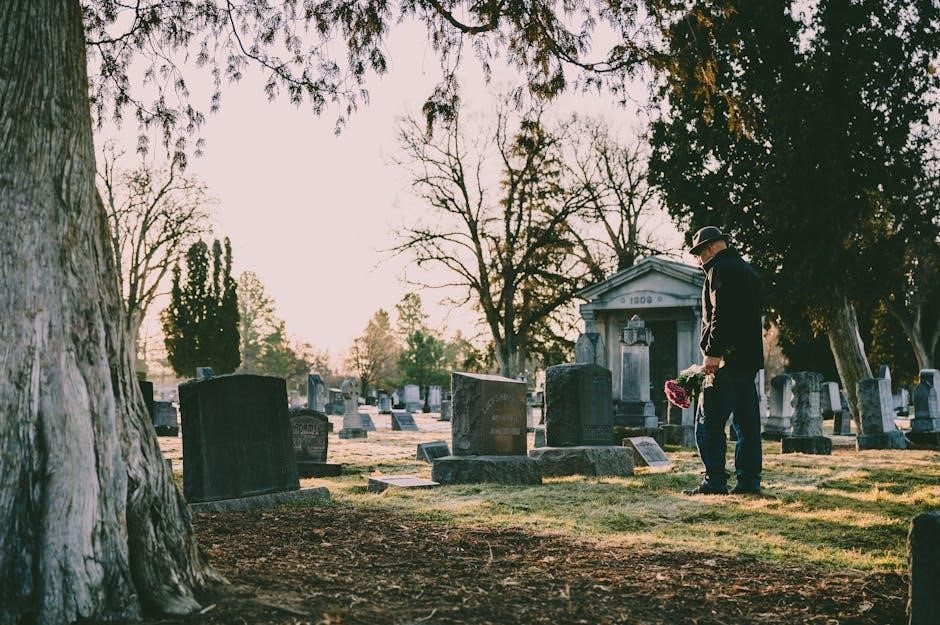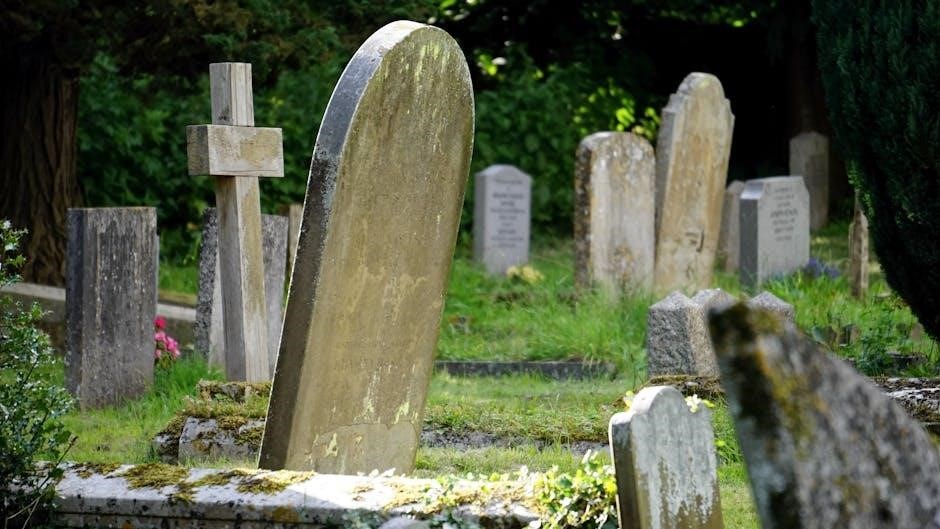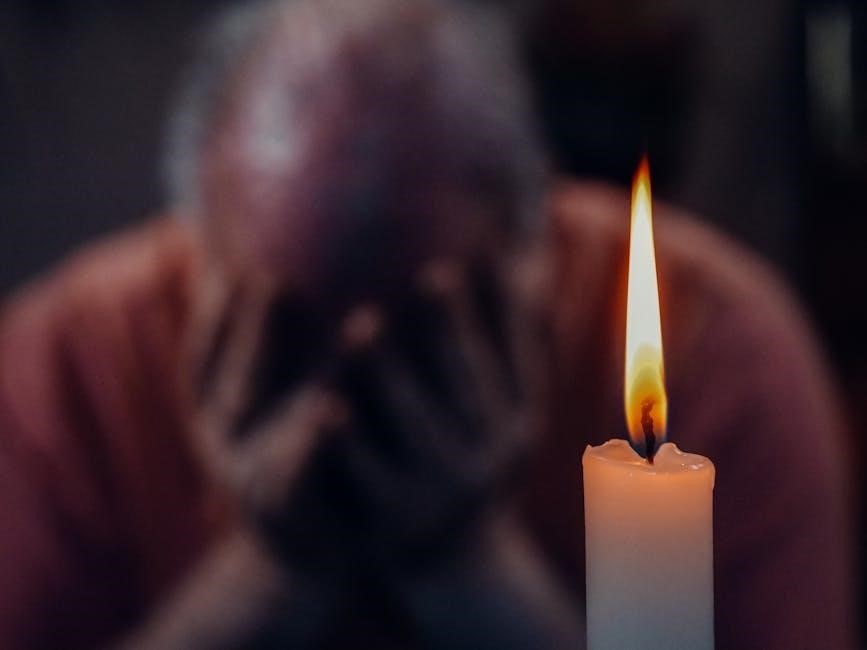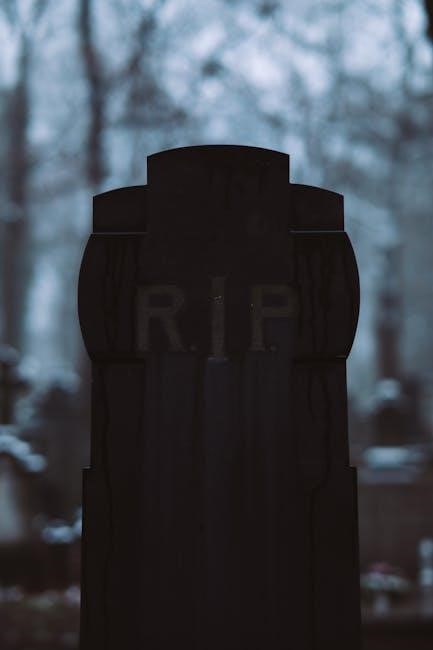“Chronicle of a Death Foretold,” a novella by Gabriel García Márquez, published in 1983, recounts the tragic murder of Santiago Nasar through a non-linear narrative, blending fate, honor, and cultural norms, while its PDF versions remain widely accessible online.
Overview of the Novel
Chronicle of a Death Foretold by Gabriel García Márquez is a gripping novella recounting the murder of Santiago Nasar, a young aristocrat, in a small Colombian town. The story, inspired by real events, explores themes of honor, fate, and societal norms through a non-linear narrative. Blending magical realism with stark realism, the novel examines the inevitability of death and the collective complicity of a community. Its concise yet powerful storytelling has made it a cornerstone of 20th-century literature, widely available in PDF formats for global readers.
Significance of the Title
The title “Chronicle of a Death Foretold” underscores the inevitability and predestination of Santiago Nasar’s fate. It reflects the community’s complicity and foreknowledge of the murder, while also highlighting the narrative’s journalistic style. The title encapsulates the blend of fate, honor, and collective guilt, central to the novella’s exploration of human nature and societal norms. Available in PDF, the title’s significance resonates deeply, inviting readers to ponder the interplay of destiny and moral responsibility.

Background and Historical Context
Gabriel García Márquez’s “Chronicle of a Death Foretold” draws inspiration from a real-life honor killing in 1950s Colombia, exploring themes of fate, honor, and societal norms.
Gabriel García Márquez: Author and Inspiration
Gabriel García Márquez, a Colombian writer, drew inspiration from a real-life honor killing in 1950s Colombia. His unique style, blending magical realism, transformed this tragic event into a rich narrative. The novella, published in 1983, reflects his fascination with fate, culture, and societal norms. Márquez’s work, including Chronicle of a Death Foretold, earned him the Nobel Prize in Literature in 1982, solidifying his legacy as a literary giant. The PDF version of the book remains widely popular for its concise yet profound exploration of human nature and destiny.
Historical Events Influencing the Novel
The novella was influenced by a real-life honor killing in 1950s Colombia, where García Márquez’s friend was murdered. This event, rooted in cultural notions of honor and violence, shaped the narrative. The political instability and societal norms of Colombia during that era are reflected in the story, providing a backdrop for the tragic events. The historical context of machismo and rigid moral codes is central to understanding the novel’s themes. The PDF versions of the book highlight these influences, offering insights into the author’s inspiration and the period’s socio-cultural dynamics.
Cultural Setting: Colombia in the 1950s
The novella is set in 1950s Colombia, a time of rigid social hierarchies and deep-rooted traditions. The cultural backdrop of honor, family reputation, and religious beliefs heavily influences the characters’ actions. The setting reflects the conservative norms of Latin American society, where machismo dominated, and women’s roles were strictly defined. The PDF versions of the book emphasize these cultural elements, providing readers with a vivid understanding of the societal context that drives the story’s tragic events and moral dilemmas. This setting is crucial to the narrative’s exploration of fate and collective guilt.

Major Themes in the Novel
The novel explores fate, honor, and death, delving into cultural norms and moral responsibility. Themes of destiny, societal expectations, and justice intertwine, shaping the tragic events.
Honor and Shame in Latin American Culture
In “Chronicle of a Death Foretold,” honor and shame are central to Latin American cultural identity. The novella portrays rigid societal expectations, where family honor is paramount. Santiago Nasar’s murder is driven by the need to restore honor after Angela Vicario’s betrayal. Gender roles are deeply intertwined, with women’s virginity symbolizing family reputation. The novel critiques the toxic norms that equate honor with violence and silence, highlighting the devastating consequences of societal pressure and collective complicity in upholding these norms.
Fate vs. Free Will
The novel explores the tension between fate and free will, as Santiago Nasar’s death appears predetermined yet preventable. The narrator repeatedly emphasizes the inevitability of the tragedy, while characters’ choices—Angela’s betrayal, the twins’ indecision—shape the outcome. This duality highlights the interplay between destiny and human agency, leaving the reader questioning whether the events were fated or a result of collective failure. The narrative underscores the futility of resisting fate, intertwined with the consequences of individual decisions.
Death and Foreboding
Death permeates “Chronicle of a Death Foretold,” with the titular tragedy foretold from the start. Omens like the smell of roses and Santiago Nasar’s unsettling premonitions create a pervasive sense of doom. The novella’s non-linear structure intensifies the foreboding, as the narrator repeatedly hints at the inevitable outcome. Supernatural elements and the townspeople’s eerie awareness of the impending murder underscore the inescapability of fate, transforming death into a central, haunting motif that dominates the narrative.
Justice and Moral Responsibility
In “Chronicle of a Death Foretold,” justice and moral responsibility are central themes, as the novella examines societal complicity in Santiago Nasar’s murder. The townspeople’s awareness of the impending tragedy yet their collective inaction raise questions about shared guilt. The twins’ brutal act, justified by a flawed sense of honor, highlights the failure of moral accountability. The novella critiques a justice system that condones violence, leaving readers to ponder the ethical implications of a society that accepts death as a resolution to shame.
Key Characters and Their Roles
Santiago Nasar, a doomed aristocrat, is the central figure whose tragic fate unfolds. The twins, his killers, act out of a misguided sense of honor, while Angela Vicario, the jilted bride, triggers the events with her accusation.
Santiago Nasar: The Doomed Aristocrat
Santiago Nasar, a wealthy, charismatic aristocrat, is the central figure whose tragic fate drives the narrative. Known for his generosity and jovial nature, he is portrayed as a victim of circumstance and rigid cultural norms. His death, foretold yet unavoidable, serves as a critique of societal expectations and honor codes. The twins, driven by a misplaced sense of duty, ultimately kill him, highlighting the destructive power of unchecked traditions and communal complicity.
The Twins: Ambivalent Witnesses
The twins, Pedro and Pablo Vicario, are central yet ambivalent figures, caught between their duty to avenge their sister’s honor and their reluctance to commit murder. Despite knowing Santiago Nasar’s fate, their indecision and moral ambiguity highlight the novel’s exploration of societal expectations and personal responsibility. Their role as both witnesses and perpetrators underscores the community’s complicity in the tragedy, making them symbolic of the collective guilt that pervades the narrative.
Angela Vicario: The Jilted Bride
Angela Vicario, the jilted bride, is a central figure whose actions ignite the tragic events. After being rejected by Bayardo San Román on their wedding night due to her lack of virginity, Angela is returned to her family, bringing shame upon them. Her brothers, Pedro and Pablo, vow to restore family honor by killing Santiago Nasar, whom Angela falsely accuses of defiling her. Her silence and passivity contrast with the violent consequences of her accusations, making her a tragic figure trapped by societal expectations of purity and honor.

Literary Devices and Style
García Márquez employs magic realism, blending the fantastical with the mundane, while using non-linear storytelling and rich symbolism to create a haunting, prophetic atmosphere in his work.
Magic Realism in the Narrative
Gabriel García Márquez masterfully employs magic realism in “Chronicle of a Death Foretold,” blending the mundane with the supernatural. The narrative intertwines factual details with fantastical elements, creating a dreamlike atmosphere. This style allows readers to connect with the story’s emotional depth while experiencing the extraordinary within the ordinary. The seamless fusion of reality and magic heightens the tragic inevitability of Santiago Nasar’s fate, showcasing García Márquez’s unique storytelling prowess and philosophical exploration of human destiny.
Symbolism and Foreshadowing
In “Chronicle of a Death Foretold,” García Márquez weaves rich symbolism and subtle foreshadowing to underscore Santiago Nasar’s inevitable doom. The yellow butterflies, a recurring motif, symbolize death and premonition. The delayed arrival of the bishop and the unheeded warnings from the dream all serve as ominous signs; These elements create a sense of inescapable fate, drawing readers into the tragic unfolding of events and emphasizing the novel’s themes of destiny and collective responsibility.
Non-Linear Storytelling
Gabriel García Márquez employs non-linear storytelling in “Chronicle of a Death Foretold,” unraveling Santiago Nasar’s murder through fragmented memories and multiple perspectives. The narrative jumps between past and present, revealing clues and insights gradually. This structure mirrors the collective memory of the town, emphasizing the inevitability of the tragedy. The PDF versions of the novel retain this complex narrative flow, immersing readers in the layered recounting of events and heightening the sense of doomed fate.
Narrative Structure and Technique
Gabriel García Márquez’s “Chronicle of a Death Foretold” masterfully employs non-linear storytelling, blending past and present through multiple perspectives, creating a layered exploration of fate and memory.
Unreliable Narrator and Multiple Perspectives
The novella features a narrator whose credibility is questionable, as he reconstructs Santiago Nasar’s murder decades later. By weaving together fragmented accounts from various townspeople, the narrative creates a mosaic of truths, highlighting the subjective nature of memory. This technique underscores the community’s collective guilt and the blurred lines between fact and myth, leaving readers to assemble the truth from multiple, often contradictory viewpoints.
Chronological Disruption
The novel employs a non-linear narrative structure, beginning with Santiago Nasar’s murder and unfolding through fragmented flashbacks. This reverse chronology disrupts traditional storytelling, immersing readers in a maze of premonitions and recollections. By weaving past and future, García Márquez builds suspense and underscores the inevitability of fate. The disjointed timeline mirrors the chaos of human memory, creating a layered exploration of events that refuses to conform to a straightforward, chronological account of the doomed aristocrat’s final days.

Moral and Ethical Dilemmas
The novel explores collective guilt and moral responsibility, as the town’s inaction and complicity in Santiago Nasar’s death highlight the ethical failures of a morally bankrupt society.
Collective Guilt and Community Complicity
In Chronicle of a Death Foretold, collective guilt permeates the narrative as the townspeople, aware of Santiago Nasar’s impending murder, fail to intervene. Their complicity, rooted in cultural norms and fear, underscores a broader moral responsibility. The novella highlights how societal expectations and silence contribute to injustice, blurring the lines between individual and communal culpability. This ethical failure reflects the destructive power of passive acceptance in the face of fate and tradition.
Moral Ambiguity in Characters’ Actions
The characters in Chronicle of a Death Foretold exhibit moral ambiguity, driven by cultural norms and personal motivations. Santiago Nasar’s fate is sealed by societal expectations, yet his actions, like his treatment of Ángela, raise ethical questions. The twins’ inaction and Ángela’s accusations reveal a complex interplay of guilt, honor, and responsibility. These moral gray areas challenge readers to question the characters’ choices and the broader ethical implications of their decisions, highlighting the tension between fate and personal accountability.

Social Commentary
Chronicle of a Death Foretold critiques societal norms, machismo, and gender roles, highlighting how these cultural expectations drive the tragic events, as detailed in its PDF versions.
Critique of Machismo and Gender Roles
Chronicle of a Death Foretold critically examines machismo and rigid gender roles in Latin American culture. Santiago Nasar, a symbol of traditional masculinity, faces a tragic fate due to societal expectations of honor. The novella highlights how toxic masculinity and the objectification of women, exemplified by Angela Vicario’s plight, perpetuate violence and inequality. Available in PDF formats, the text underscores the destructive consequences of rigid gender norms and the community’s complicity in upholding them.
Religious Hypocrisy and Superstition
Chronicle of a Death Foretold explores the interplay of religious hypocrisy and superstition in a conservative Latin American town. The novella critiques the societal acceptance of fate as divine will, while the Catholic Church remains complicit in the tragedy. Superstitions, such as omens and the bishop’s “miracle,” are woven into the narrative, highlighting the community’s dual reliance on faith and fatalism. Available in PDF formats, the text underscores how religious norms perpetuate moral ambiguity and societal complacency in violence.
Reception and Reviews
Chronicle of a Death Foretold received widespread critical acclaim for its profound exploration of fate and societal norms. Available in PDF formats, it sparked debates on justice and morality.
Critical Acclaim and Awards
Chronicle of a Death Foretold earned Gabriel García Márquez widespread recognition, including the Nobel Prize in Literature. Critics praised its intricate exploration of fate, honor, and societal norms. The novella’s unique blend of magic realism and a gripping narrative solidified its status as a literary masterpiece. Its availability in PDF formats has made it accessible to global readers, further cementing its reputation as a benchmark of contemporary literary fiction.
Controversial Discussions
Chronicle of a Death Foretold sparked debates over its graphic violence and critique of societal norms. Some viewed Santiago Nasar’s fate as a condemnation of machismo and honor culture, while others questioned the moral ambiguity of the community’s inaction. The novella’s exploration of justice and morality led to discussions about collective guilt and ethical responsibility, making it a controversial yet thought-provoking work available in PDF formats for global readers to engage with and reflect upon.

Cultural and Literary Impact
Chronicle of a Death Foretold significantly influenced magical realism, inspiring global literary movements. Its exploration of honor and fate resonated deeply, shaping Latin American literature and beyond, while its PDF availability ensured widespread accessibility and enduring relevance in modern culture and academia.
Influence on Magical Realism
Chronicle of a Death Foretold solidified Gabriel García Márquez’s role as a pioneer of magical realism, blending the fantastical with the mundane. The novel’s intricate narrative and symbolic elements inspired writers globally, defining the genre’s boundaries. Its exploration of fate and cultural norms through a surreal lens remains a benchmark, influencing countless literary works and cementing its place as a cornerstone of magical realist literature.
Adaptations and Interpretations
Chronicle of a Death Foretold has been adapted into various forms, including a musical by Jim Lewis and Graciela Daniele, which garnered critical acclaim. Its themes of fate and honor have inspired numerous interpretations, from stage productions to academic studies. The novella’s PDF versions are widely available, making it accessible for global readers and scholars to explore its rich narrative and symbolic depth, further cementing its influence in literary and cultural discourse.

Education and Analysis
Chronicle of a Death Foretold is widely studied in educational classrooms, offering deep insights into themes like fate and honor, with PDF versions enhancing accessibility for analysis.
Teaching the Novel in Classrooms
Chronicle of a Death Foretold is frequently taught in literature classes due to its rich themes, such as fate, honor, and morality. Educators use its concise narrative to explore complex cultural dynamics, making it ideal for analyzing magical realism and moral ambiguity. PDF versions of the novel are widely available, aiding classroom accessibility. Academic studies and essays further enhance its educational value, providing deeper insights into its historical and literary significance for students and educators alike.
Academic Studies and Essays
Academic studies and essays on Chronicle of a Death Foretold explore its rich thematic layers, such as fate, honor, and moral responsibility. Scholars often analyze the novella through the lens of magical realism and cultural critique. PDF versions of critical essays are widely available, offering insights into the novel’s historical context and narrative structure. Researchers also examine the unreliability of the narrator and the societal norms portrayed, making it a focal point for literary analysis and academic discourse.
Availability and Formats
Chronicle of a Death Foretold is widely available in PDF and digital formats, with numerous translations and editions accessible online, ensuring global readership and academic accessibility.
PDF and Digital Versions
Chronicle of a Death Foretold is readily available in PDF and digital formats, accessible through platforms like Google Books, Internet Archive, and online libraries; These versions provide convenience for readers, allowing easy access to the novella. Digital editions often include features like adjustable fonts and bookmarks, enhancing readability. PDF downloads are particularly popular among students and researchers for academic purposes, making the text widely accessible globally. This digital presence ensures the novella remains relevant and easily attainable for modern audiences.
Translations and Editions
Chronicle of a Death Foretold has been translated into numerous languages, ensuring its global reach. Gregory Rabassa’s English translation is particularly acclaimed for preserving the novella’s essence. Various editions, including paperback, hardcover, and e-book formats, cater to diverse readers. The book’s timeless themes are maintained across translations, making it accessible to a wide audience while retaining its cultural and literary depth. This versatility highlights its enduring relevance in world literature.

Related Works by García Márquez
Gabriel García Márquez is renowned for works like One Hundred Years of Solitude and Love in the Time of Cholera, both exploring magical realism and human destiny.
One Hundred Years of Solitude
Gabriel García Márquez’s seminal work, One Hundred Years of Solitude, explores the cyclical fate of the Buendía family in the mystical town of Macondo. This masterpiece of magical realism weaves together themes of love, solitude, and the inevitability of destiny, mirroring the intricate narrative style found in Chronicle of a Death Foretold. Its enduring popularity has solidified its place as a cornerstone of 20th-century literature, continuing to captivate readers worldwide.
Love in the Time of Cholera
Gabriel García Márquez’s Love in the Time of Cholera (1985) is a mesmerizing tale of enduring love and passion, spanning decades. The novel follows Florentino Ariza’s unwavering devotion to Fermina Daza, set against the backdrop of societal expectations and personal struggles. Written in Márquez’s signature magical realism style, the book explores themes of love, aging, and resilience. Its profound emotional depth continues to resonate with readers, making it a timeless classic alongside Chronicle of a Death Foretold.

Legacy of “Chronicle of a Death Foretold”
Gabriel García Márquez’s novella remains a landmark in world literature, influencing magical realism and sparking global discussions on fate, honor, and societal norms, ensuring its timeless relevance.
Enduring Relevance in Modern Literature
Gabriel García Márquez’s “Chronicle of a Death Foretold” continues to captivate readers with its exploration of fate, honor, and moral ambiguity, resonating across generations. Its themes of societal expectations, toxic masculinity, and collective guilt remain pertinent in today’s discussions of justice and ethics. The novel’s magical realism and non-linear narrative have influenced countless writers, while its timeless questions about human nature ensure its place in modern literary discourse and academic studies, accessible now through widely available PDF editions.
Impact on Global Literary Movements
Gabriel García Márquez’s “Chronicle of a Death Foretold” significantly influenced global literary movements by popularizing magical realism and inspiring writers worldwide. The novel’s exploration of fate, honor, and cultural norms resonated across borders, shaping the “Boom” of Latin American literature. Its innovative narrative style and profound themes have made it a cornerstone of modern literary studies, with its PDF versions widely used in classrooms and scholarly analyses, ensuring its enduring influence on both academic and creative fields.
